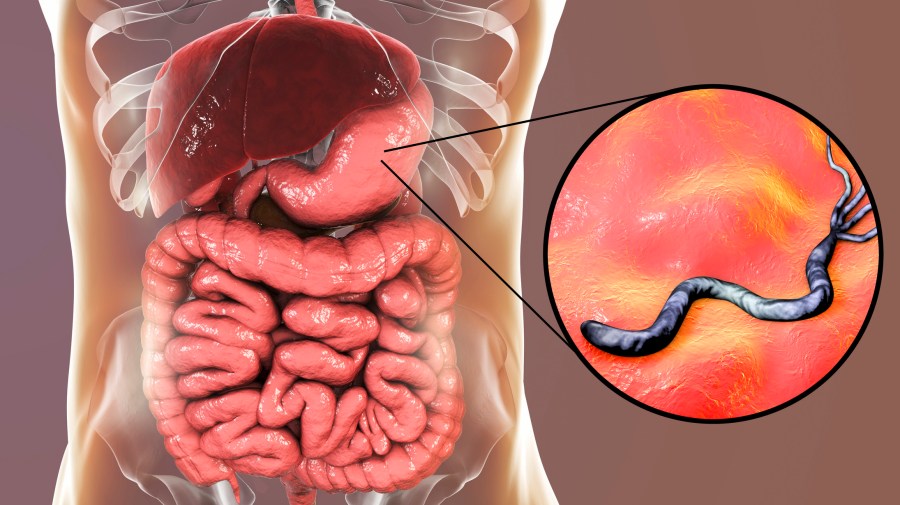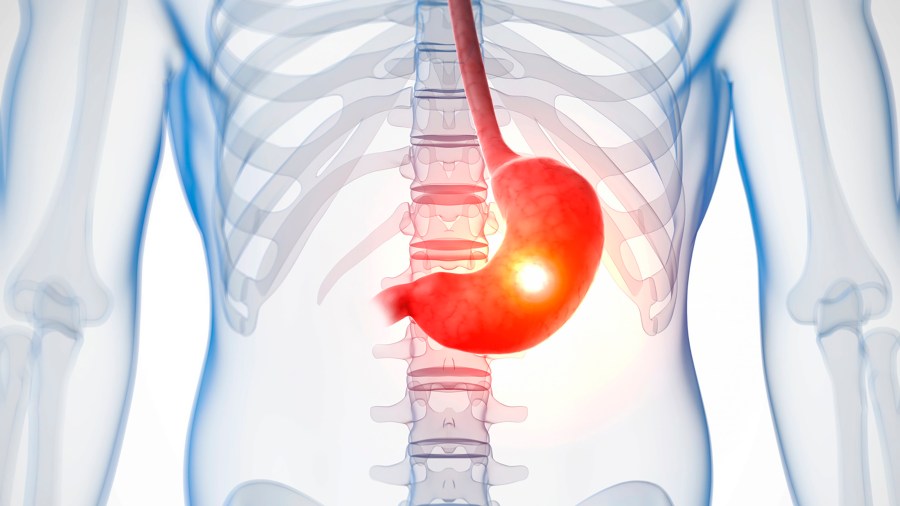Try Try Again by T H Palmer

The human body is fabricated up of several critical systems — 1 of which is the digestive system — that are essential to our health. When the digestive system isn't working properly, the consequences can become uncomfortable and painful very quickly. In some cases, digestive issues become far beyond discomfort and lead to dangerous health conditions.
Bacteria like Helicobacter pylori (H. pylori) are oft behind gastrointestinal conditions, such every bit peptic ulcers and fifty-fifty tum cancer. H. pylori infects the stomach and is particularly dangerous considering virtually people don't realize they take the bacterial infection until they develop painful symptoms. On the positive side, it's possible to treat the infection, fifty-fifty years subsequently information technology starts, but to do and then, you demand to recognize the potential symptoms of H. pylori.
Causes of H. Pylori
H. pylori infections oftentimes outset at a young historic period, but the typical mode of infection hasn't been officially proven. Near medical experts believe the leaner spreads from kissing and other close person-to-person contact or from consuming contaminated food or water. The bacteria are widespread, with large numbers of people all over the world infected with strains. Approximately 50% of people coming to the U.Southward. from developing Latin countries and Eastern European countries are infected, for example.

The H. pylori bacteria doesn't discriminate, merely those living in certain conditions are more likely to be exposed. People who live with many other people are more likely to contract information technology, particularly if they live in close quarters. Those in developing countries are also more than susceptible, especially if consistent access to clean running water is a problem. Additionally, anyone living with or having shut contact with someone else who is infected is almost sure to become infected.
Symptoms of H. Pylori
Some people announced to be naturally resistant to H. pylori and never experience whatever symptoms or don't experience them for many years. This makes it almost incommunicable to treat H. pylori early before some damage has been washed to the stomach and intestines. In most cases, the first indicators of H. pylori infections appear when people get-go to experience the early symptoms of ulcers or gastritis.

Gastritis causes redness and swelling in the stomach lining, and ulcers cause bodily sores, haemorrhage and eventually holes in the lining. The milder symptoms of ulcers include bloating, burping, nausea, vomiting, loss of appetite and weight loss. Every bit the ulcers worsen, the symptoms escalate to include anemia and ongoing dull hurting in the breadbasket, especially several hours after eating or when the tummy is empty. Eating or taking antacids typically alleviates the pain for a short fourth dimension.
Diagnosis of H. Pylori
When patients are diagnosed with ulcers or gastritis, doctors will try to decide the cause, and that includes testing for H. pylori bacteria. Stool sample testing provides information about many different types of leaner in the intestinal tract, while stool antigen testing looks specifically for the H. pylori bacteria. Certain blood tests can also detect H. pylori antibodies in the blood.

The H. pylori leaner makes an enzyme known as urease. This enzyme reduces the acidity of breadbasket acid and weakens the stomach lining, making information technology easier for ulcers to develop. Breath tests can expect for carbon in the jiff, which indicates the presence of urease. In more than extreme cases, doctors may perform an upper endoscopy, which involves running a tube with a small photographic camera down the esophagus and into the stomach and upper intestine (duodenum). This allows them to take tissue samples besides as examine potential damage.
Handling of H. Pylori
Fortunately, H. pylori can be treated at whatsoever stage, although the form of handling varies based on the severity of the condition, the patient's age and the exact symptoms. It's common to accept multiple medications to ensure the infection is eliminated. 2 different antibiotics taken simultaneously can help foreclose antibiotic resistance in the bacteria, while acrid-reducing medications give the tummy lining a run a risk to heal.

Common acid reducers include histamine (H-2) blockers, proton pump inhibitors and tummy lining protectors. The most common stomach lining protector is Pepto-Bismol, a bismuth subsalicylate, which coats the stomach lining to protect it from acid. H-2 blockers prevent the product of histamine, a substance that helps the stomach make acid. Proton pump inhibitors actually stop the stomach's acid pump from working, which inhibits the production of acid.
Complications of H. Pylori
Gastritis and peptic ulcers are the well-nigh common weather condition acquired by H. pylori bacteria, although not everyone infected with the leaner will become ill. Besides pain and other uncomfortable symptoms, ulcers can cause bleeding and holes in the lining of the stomach. Depending on the position of the ulcer, it could too crusade stomach blockages. In the worst cases, these bacterial infections can crusade gastric cancer, which is the second leading cause of cancer deaths in the earth.

fragosobountiturill.blogspot.com
Source: https://www.reference.com/world-view/symptoms-h-pylori-2abba589d8032674?utm_content=params%3Ao%3D740005%26ad%3DdirN%26qo%3DserpIndex
0 Response to "Try Try Again by T H Palmer"
Post a Comment